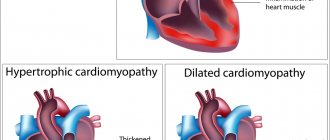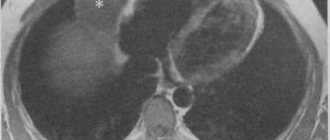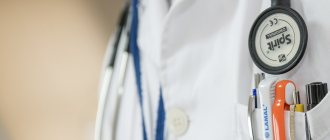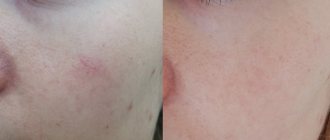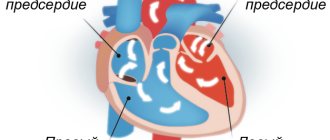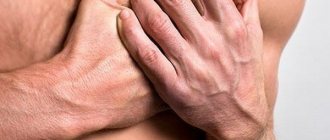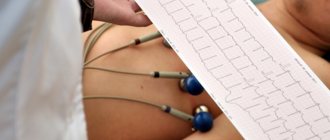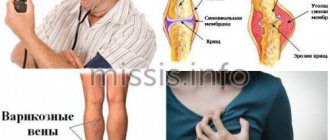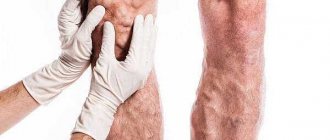What is thrombophlebitis
Thrombophlebitis is an inflammation of the venous wall with the formation of a blood clot in the lumen of the vein.
Most often, thrombophlebitis occurs in the veins of the lower extremities, but in some cases it can be localized in the veins of the upper extremities, chest, and neck. Experts usually call inflammation and thrombosis of the superficial saphenous veins thrombophlebitis. In the case of deep vein thrombosis, another term is more often used - “ phlebothrombosis ”.
In the case of inflammation of the vascular wall, in the absence of a blood clot in the lumen of the vein, the term “ phlebitis ” is used.
What is the danger of blockage (thrombosis) of the veins in the legs if it is not treated?
Diagnosis of leg vein thrombosis and timely initiation of treatment are extremely important not only for maintaining health, but also for the life of the patient. After all, if a blood clot formed in a vein completely blocks its lumen, this can lead to an embolism. In turn, this condition can cause insufficient blood flow to the organs. For example, a blood clot that breaks off and blocks a pulmonary artery can lead to the development of a pulmonary embolism, a life-threatening condition that is often fatal.
What other complications should you be aware of in order to start treatment of thrombosis on time?
blockage of blood vessels
- If left untreated, chronic venous insufficiency may develop.
- The situation may be aggravated by the addition of inflammation to thrombosis - in this case, the patient develops thrombophlebitis.
- We should not exclude the possibility of developing decompensation of varicose veins - a condition that occurs when the deep veins in the legs are completely blocked. As a result, a person develops trophic ulcers - long-healing wounds that cause pain and serious discomfort.
blood vessels, disease
- The presence of blood clots negatively affects the appearance of the lower extremities, causing psychological discomfort to patients (especially women). Swelling and bluish tint of the legs can interfere with your personal life and negatively affect social adaptation. This creates a vicious circle: a person begins to feel embarrassed about his condition, tries to limit his social circle and go out as little as possible - as a result, this leads to a decrease in physical activity, which further aggravates the symptoms of thrombosis.
Correlation between diseases of the circulatory system and mortality from them
Causes of thrombophlebitis
The main causes of venous thrombosis:
- inflammatory process (local and/or general),
- slowing down the flow of blood through the venous vessels, leading to venous stagnation (for example, due to varicose veins),
- hereditary or acquired tendency of the blood to form blood clots (coagulopathies or thrombophilic conditions),
- damage to the venous wall (sometimes even minor trauma to the vessel, for example, catheterization of a vein).
How to treat blockage (thrombosis) of veins in the legs at home?
You should not completely replace medications prescribed by your doctor with the use of traditional recipes. “Grandmother’s” advice can act as an additional measure, but treatment of vein thrombosis should in no case be based solely on them.
blocked veins in the legs
To treat thrombosis at home, decoctions and infusions of herbs are used, which are taken orally and applied externally to the affected areas of the legs - as applications. Herbal medicines can also be used to prepare homemade ointments. What plants are suitable for fighting blood clots?
- Horse chestnut. This is one of the most famous traditional medicines that prevents the formation of blood clots. To prepare the tincture, wash a glass of chestnuts, chop them and pour 800 ml of vodka, then put them away in a dark place for 3 weeks. When the infusion is ready, it is used for oral administration. You can also prepare an ointment from chestnut cores. To do this, the horse chestnut fruits are peeled from the brown shell, the resulting kernels are dried in the oven, crushed and mixed with butter. The resulting ointment is stored in the refrigerator and used to rub the feet.
- Lemon and garlic. These products help thin the blood, so they are actively used in folk medicine to combat blood clots. To prepare the tincture, take a medium head of garlic and a large lemon, grind it in a blender or pass it through a meat grinder. The resulting pulp is placed in a jar, filled with warm water (not boiling water) and left for several days, after which a few sips are taken before each meal.
- Cranberries or blueberries. The berries are crushed in a blender or passed through a meat grinder, mixed with honey to taste and taken a tablespoon several times a day.
- Vinegar. For 50-60 ml of apple or grape cider vinegar, take 4 tablespoons of honey, mix until smooth, lubricate the legs with the resulting mixture, wrap with cling film and hold for about 15-20 minutes.
!
Thrombosis is a serious pathology and traditional medicine alone will not be enough to combat it. So if you decide to undergo treatment at home, do not forget to consult your doctor first.
Symptoms of thrombophlebitis
- soreness,
- the appearance of local swelling of the limb,
- temperature rise,
- thickening and redness along the affected vein.
In the case of thrombophlebitis of the superficial veins, the patient may notice a gradual increase in the intensity of the changes described above over several days.
If you have these symptoms, you should definitely consult a specialist.
However, with deep vein thrombosis (phlebothrombosis), the main symptom is most often swelling of the affected limb, although it should be remembered that many patients with this form of the disease may not have any symptoms for a long time.
If swelling and pain are severe, and are also accompanied by high fever or shortness of breath with coughing attacks or chest pain, it is necessary to call an ambulance team.
These symptoms may indicate the development of deep vein thrombosis, which significantly increases the likelihood of a blood clot breaking off and migrating into the vessels of the lungs.
Thrombosis of the lower extremities - symptoms
An additional danger of thrombosis is that the disease may not manifest itself for a long time. Symptoms appear when the blood clot reaches a large size and spreads up the vessel. Then the patient begins to complain of pain, which decreases at rest and increases with physical activity. Then, due to the deterioration of blood outflow, swelling is added to the pain. The skin on the leg turns pale (to the point of cyanosis) and “tightens”, acquiring a glossy shine.
To diagnose the localization of a blood clot, an ultrasound of the veins is performed, and in particularly difficult cases, angiography, an X-ray examination with the introduction of a contrast agent into the vessels.
Risk factors for the development of thrombophlebitis
- pregnancy, childbirth, gynecological operations (including abortions).
- varicose veins;
- prolonged bed rest (for example, after surgical and orthopedic operations);
- infectious diseases;
- stroke leading to paralysis of the limbs;
- motionless body position during a long trip by car or plane;
- obesity;
- oncological diseases (including surgical treatment of malignant neoplasms, radiation therapy and chemotherapy);
- dehydration;
- the use of hormonal contraceptives and other sex hormone preparations for the purpose of replacement therapy;
- increased blood clotting (hyperhomocysteinemia, antiphospholipid syndrome, etc.);
- puncture and/or venous catheterization.
The more risk factors a patient has, the higher the risk of developing thrombophlebitis.
If you have one or more factors from the above list, consult a specialist about methods of preventing venous thrombosis.
Blockage (thrombosis) of a vein in the leg: what to do for prevention?
Rationalization of work and rest schedules, wearing special compression garments and correcting nutrition - all this has a beneficial effect on the condition of blood vessels and helps reduce the risk of thrombosis of the leg veins.
Preventative exercise
When the first symptoms of thrombosis appear, the patient is advised to reconsider his attitude towards physical activity. It is advisable to avoid staying in any static position for a long time - either sitting or standing, or lying down. During the day, you need to perform not very difficult physical exercises, and if this is not possible, then at least change your body position as often as possible.
Massage
As a preventive measure, you can practice self-massage, as it relieves the feeling of tightness and improves blood flow. However, remember that if you have thrombophlebitis with dilated and painful veins, you cannot do a massage.
foot massage
Compression underwear
Since one of the reasons for the development of blockage (thrombosis) of the veins of the lower extremities is varicose veins, wearing special compression products - stockings, tights, knee socks, elastic bandages - gives good results in the fight against this problem. Their use has a beneficial effect on the speed of venous blood movement. Each patient can choose the type of compression garment that suits them, depending on the level of pressure exerted by the product on the lower extremities.
compression underwear
Hirudotherapy
Installing medical leeches is an effective means of preventing varicose veins on the legs. The saliva of leeches contains a special component - hirudin, which is a natural anticoagulant. This substance reduces blood viscosity, improves blood flow in the lower extremities, and increases local and general immunity.
!
It is worth considering that hirudotherapy has contraindications (oncology, purulent processes, etc.)
In addition, the placement of leeches cannot be combined with the use of medicinal anticoagulants, as this can lead to complications, such as the development of bleeding.
Nutritional Features
A properly formulated diet allows you to lose excess weight, which puts additional pressure on the lower limbs, and also reduce blood viscosity. To achieve these goals, it is recommended to adhere to the following rules:
- Drink enough clean drinking water daily (up to 2 liters per day). Reduce coffee consumption, give up alcohol, limit, or better yet completely eliminate, milk and dairy products.
- Eat foods rich in heavy animal fats: fatty meats, butter, lard. Healthy sources of fat and protein are sea fish, seafood, vegetable oils (olive, flaxseed, MCT oil), replace milk with soy, almond, coconut.
- Completely exclude from the diet trans fats, margarine, smoked and salty foods, fatty sauces, chips and snacks, sweet carbonated drinks, milk chocolate, baked goods, bread, fast food.
- The daily menu should include vegetables, herbs, and fruits, which contain fiber.
- It is recommended to further enrich the diet with foods that include vitamins C, E and Beta-carotene. They are natural antioxidants that help reduce blood hypercoagulability. Such products include citrus fruits, kiwi, cranberries, raspberries, blueberries, apples, spinach, sea buckthorn, green tea, carrots, bell peppers, red beans, nuts, sunflower seeds. It is also worth eating foods that contain vitamin P (rutin). It maintains vascular tone at a high level, ensures their strength and elasticity. Contained in cherries, tomatoes, garlic, chokeberries, sorrel, buckwheat.
- Don’t forget about foods that increase the production of elastin, a protein that ensures the elasticity and strength of blood vessels. These include seafood, red grapes, and beef liver.
PLEASE NOTE: The recommendations described above are general guidelines. Therefore, it is advisable that the daily diet be compiled by a doctor taking into account an assessment of the patient’s general health.
Confirmation of the diagnosis of thrombophlebitis
During the examination, the specialist individually selects the required minimum of research for each specific case. To confirm or exclude thrombophlebitis of the lower extremities, your doctor may choose one of the following diagnostic methods:
- Blood tests (clinical blood test, coagulogram, D-dimer);
- Venography (X-ray examination of the venous bed using the injection of a contrast agent that stains the vessels from the inside). Currently, due to the development of low-traumatic and highly informative research methods (primarily duplex angioscanning), it is used extremely rarely;
- Computed tomography and magnetic resonance imaging in vascular mode - performed in situations where ultrasound diagnostic methods are not very informative;
- Ultrasound diagnostic methods (Dopplerography and duplex angioscanning) are currently the “gold standard” for diagnosing thrombophlebitis.
After a diagnosis has been established, you may need additional diagnostics to identify the causes of thrombophlebitis, as well as control studies to clarify the nature of the dynamics of the pathological process.
Treatment methods for thrombophlebitis
Treatment of thrombophlebitis of superficial veins
In this case, the specialist may recommend treatment on an outpatient basis. The list of recommendations may include medications:
- having an anti-inflammatory effect (non-steroidal anti-inflammatory drugs, for example: Nimesil, Ibuprofen, Diclofenac, Nise, etc.);
- local remedies (compresses and ointments);
- compression methods (elastic bandages or compression hosiery, etc.);
- phlebotonic agents (Detralex, Phlebodia, Antistax, Vasoket, etc.).
With thrombophlebitis of the superficial veins, the patient rarely needs hospitalization and, with proper treatment, as well as careful adherence to medical recommendations, relief usually occurs quickly.
With the progression of superficial thrombophlebitis (growth of the thrombus border), surgical prevention of thromboembolism (separation and migration of thrombotic masses into the vessels of the lungs) and the spread of thrombosis to the deep vein system may be required. Surgical intervention in this case is performed according to urgent indications and most often consists of ligating the thrombosed superficial vein (great or small saphenous vein) at the point where it flows into the deep vein system and, if possible, removing varicose veins (thrombosed and non-thrombosed) veins.
Treatment of deep vein thrombosis
Drug therapy
Injections of blood thinning drugs - anticoagulants (heparin or its modern analogues: Clexane, Fraxiparin, Fragmin). After heparin therapy, long-term use of the tablet form of another blood thinning drug, warfarin, may be prescribed. Treatment with anticoagulants is carried out to prevent the growth of a blood clot and prevent recurrence of venous thrombosis.
If your doctor has prescribed you warfarin, strictly follow the instructions for taking the drug and monitoring your blood clotting.
Warfarin is a powerful drug that can cause a number of dangerous side effects if you do not follow your doctor's instructions.
Compression therapy
The use of elastic bandages and the selection of individual compression hosiery is one of the main tools for therapeutic effects, as well as prevention for deep vein thrombosis. Consult a specialist about possible compression therapy methods in your case.
Implantation of vena cava filter
In some cases, especially if there are contraindications to blood-thinning drugs or their ineffectiveness, a vena cava filter device can be installed in the main vein of the patient's body (inferior vena cava) to prevent the migration of detached fragments of blood clots from the veins of the lower extremities to the vessels of the lungs. The vena cava filter acts as a trap for detached blood clots. The filter can be installed for a certain period of time (3-4 weeks) or permanently. This procedure is most often performed under local anesthesia and does not require a long hospital stay.
Surgery
Thrombectomy, venous angioplasty and venous bypass.
In some cases, it may be necessary to perform a surgical intervention aimed at removing thrombotic masses of large venous trunks (thrombectomy) in the lower extremities, pelvis or abdomen. To treat long-standing blockage, bypass surgery or minimally traumatic intervention (stenting) of the affected segment of the main vein is sometimes performed.
The volume and nature of surgical intervention for deep vein thrombosis is determined individually by the vascular surgeon.
Thrombolysis
Dissolution of thrombotic masses with the help of special drugs - thrombolytics (urokinase, actilise, etc.). This procedure can only be performed in the early stages of the disease and has a number of special contraindications.
Diet for thrombophlebitis
A large amount of fresh vegetables, fruits, fiber, nuts, cereals, whole grain breads. Among products of plant origin, the following also have a beneficial effect on venous diseases:
- ginkgo biloba,
- ginger,
- red capsicum,
- valerian root,
- garlic,
- hawthorn berries.
Nutritional supplements and vitamins:
- vitamins C, A, E and B6,
- linseed oil,
- magnesium and calcium (in combination),
- Pycnogenol
Recommendations for changing the lifestyle of patients with thrombophlebitis
- Elevated position of the lower extremities during rest and sleep;
- Avoid prolonged static loads;
- Avoiding heavy physical activity (weight lifting);
- Avoid overheating and dehydration (long stay in the bathhouse);
- Wear compression hosiery of the required compression class (determined by a specialist);
- Limiting static loads (avoid sitting for long periods of time, standing without moving);
- Constant physical activity - walking, swimming, cycling;
- Selection of comfortable shoes and orthopedic insoles.
